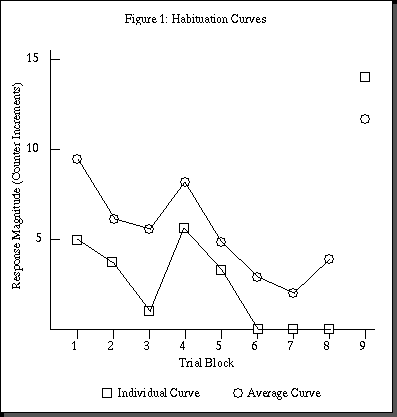Example of a Good Results Section for Study 2
This is a Methods section from one of the students in the class. It is a good example of what a good Methods section for this study looks like. I have taken the liberty of making a couple of minor modifications.
Results
The individual curve in Figure 1 shows the subject's response magnitude over the 16 habituation trials and two dishabituation trials, collapsed into nine trial blocks. Each trial consists of the average response magnitude of two consecutive trials. For the habituation blocks, the subject exhibited a low level of responding, with a narrow range of 0 to 5 counter increments. The subject's level of responding at the start of the habituation phase (block 1) was higher than at the end of this phase (block 8); however, the level of responding did not decrease smoothly as trials progressed. Instead, the subject's response magnitude dipped during block 3 and rose during block 4 to the same level as in block 1. After block 4, the level of responding decreased continuously to hit zero counter increments at block 6. The subject's response magnitude remained at zero until the dishabituation phase (block 9), at which point the subject's response magnitude jumped to an average of 13.5 counter increments.
Figure 1 also displays an average habituation curve calculated using this subject and two other subjects run in the same experiment under the same conditions. In the habituation phase for the average curve, a pattern of response magnitudes similar to that in the individual curve was seen. Level of responding decreased from 9.5 counter increments in block 1 to 5.7 cunter increments in block 3, increased to 8.5 counter increments in block 4, and decreased from then on. After hitting a low of 2.9 counter increments on block 7, response magnitude increased to 4.5 counter increments on block 8. In the dishabituation phase for the average curev, response magnitude increased to 11 counter increments.

Psych 482 Main Page